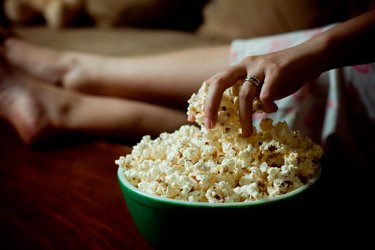
If you have diverticulitis and have been avoiding eating corn or you're afraid to eat popcorn or seeds, you don't need to worry. The best diverticulitis diet is made up of healthy, high-fiber foods, which can include corn and popcorn.
Years ago, doctors worried that corn and seeds might be harmful to people with diverticulosis. But the ban on nuts, seeds, corn or popcorn has been outdated since an 18-year Harvard study came out in 2008, Harvard Health Publishing says. In the study, men with the highest diets of nuts and popcorn actually had less diverticulitis than men who avoided these foods.
Video of the Day
Video of the Day
"I am still shocked to find patients with diverticulosis or diverticulitis still avoiding corn, seeds and nuts," says Susanne Shokoohi, MD, an assistant professor of gastroenterology at Loyola University Medical Center in Maywood, Illinois. "These types of high-fiber foods are actually good for people with diverticular disease."
There is no need to avoid nuts or popcorn or sesame seeds, the National Institute of Diabetes and Digestive and Kidney Diseases (NIDDK) says, and seeds from tomatoes, cucumbers and berries are also acceptable foods for people with diverticulosis or diverticulitis.
Diverticulosis and Diverticulitis Explained
To have diverticulitis, you have to first have diverticulosis, says NIDDK. Together diverticulosis and diverticulitis are called diverticular disease. A single diverticulum is a weakness in the wall of your colon, which is the last part of your digestive system, where water is absorbed and stool is formed.
The weakness allows a pouch or pocket to form and protrude from the lining of your colon, NIDDK explains. Most people have many pouches, called diverticulosis. Diverticulosis is most common in the last part of your colon, which is on your left side. Diverticulitis is when the pouches in the lining of the colon become inflamed.
"Diverticulosis increases with age and is very common," says Dr. Shokoohi. "You may be at higher risk for this condition if you are over age 60, are a smoker, are overweight, have a family history of the condition, eat a low-fiber diet or eat lots of red meat."
Diverticulosis is so common that by age 85, two-thirds of Americans have the condition, Harvard Health Publishing says. The main cause is probably a diet that is too low in fiber and causes you to be constipated or to strain at passing small, hard stools. Over time, this can cause a diverticulum to push through the walls of the colon.
What Causes Diverticulitis?
If diverticulitis is not caused by seeds or food particles getting stuck inside a diverticulum, what is the cause? The exact cause is not completely known, but it may be inflammation from tiny tears inside diverticulum due to pressure inside the colon, called microperforations, Dr. Shokoohi says.
Diverticulitis may also be caused by bacteria that get inside a diverticulum and cause infection, says NIDDK. The most common symptoms include left-sided lower belly pain along with chills and fever. There may also be constipation, diarrhea, nausea and vomiting, the research organization adds. However, most people with diverticulosis never have diverticulitis — probably less than 5 percent, it says.
Another complication of diverticulosis, other than diverticulitis, is bleeding, says Harvard Health Publishing. This occurs when tiny blood vessels inside a diverticulum rupture and bleed. Bleeding may occur in up to 10 percent of people and can be light to heavy, Harvard Health adds. Any bleeding requires a medical evaluation.
Does Diet Play a Role?
Diet does play a role in prevention of diverticular disease and treatment of diverticulitis. "To prevent diverticulosis, you should eat a diet that is high in fiber from fruits, vegetables, nuts, beans and whole grains," Dr. Shokoohi says. "This, along with drinking enough fluid, maintaining a healthy weight and not smoking, should reduce your risk of diverticulosis."
If you do develop diverticulosis, you can reduce your risk of diverticulitis with the same healthy diet, says Harvard Health For a man up to age 50, that means a diet that includes 38 grams of fiber a day. For a woman, the recommended amount is 30 grams. You may need less after age 50, says the American Academy of Family Physicians, so ask your doctor what amount is best for you.
Dr. Shokoohi explains that diet is also important if you have an active bout of diverticulitis. In this case, you may need to go on a clear liquid diet until the inflammation in your colon calms down. You may also need to take antibiotics. As your symptoms improve, you can gradually return to your normal diet.
Read more: Is Sugar Bad for Diverticulitis?
- Susanne Shokoohi, MD, assistant professor, gastroenterology, Loyola University Medical Center, Maywood, Illinois
- National Institute of Diabetes and Digestive and Kidney Diseases: "Eating, Diet and Nutrition for Diverticular Disease"
- Harvard Health Publishing: "Diverticular Disease of the Colon"
- National Institute of Diabetes and Digestive and Kidney Diseases: "Definition and Facts for Diverticular Disease"
- National Institute of Diabetes and Digestive and Kidney Diseases: "Symptoms and Causes of Diverticular Disease"
- American Academy of Family Physicians: "Fiber: How to Increase the Amount in Your Diet"
Is this an emergency? If you are experiencing serious medical symptoms, please see the National Library of Medicine’s list of signs you need emergency medical attention or call 911.